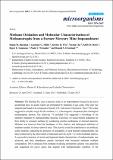Methane Oxidation and Molecular Characterization of Methanotrophs from a Former Mercury Mine Impoundment
Author(s)
Baesman, Shaun M.; Miller, Laurence G.; Wei, Jeremy H.; Cho, Yirang; Welander, Paula V.; Oremland, Ronald S.; Baesman, Shaun; Miller, Laurence; Wei, Jeremy; Matys, Emily; Summons, Roger; Welander, Paula; Oremland, Ronald; Summons, Roger E; ... Show more Show less
Downloadmicroorganisms-03-00290.pdf (893.5Kb)
PUBLISHER_CC
Publisher with Creative Commons License
Creative Commons Attribution
Terms of use
Metadata
Show full item recordAbstract
The Herman Pit, once a mercury mine, is an impoundment located in an active geothermal area. Its acidic waters are permeated by hundreds of gas seeps. One seep was sampled and found to be composed of mostly CO₂ with some CH₄present. The δ¹³CH₄value suggested a complex origin for the methane: i.e., a thermogenic component plus a biological methanogenic portion. The relatively ¹²C-enriched CO₂ suggested a reworking of the ebullitive methane by methanotrophic bacteria. Therefore, we tested bottom sediments for their ability to consume methane by conducting aerobic incubations of slurried materials. Methane was removed from the headspace of live slurries, and subsequent additions of methane resulted in faster removal rates. This activity could be transferred to an artificial, acidic medium, indicating the presence of acidophilic or acid-tolerant methanotrophs, the latter reinforced by the observation of maximum activity at pH = 4.5 with incubated slurries. A successful extraction of sterol and hopanoid lipids characteristic of methanotrophs was achieved, and their abundances greatly increased with increased sediment methane consumption. DNA extracted from methane-oxidizing enrichment cultures was amplified and sequenced for pmoA genes that aligned with methanotrophic members of the Gammaproteobacteria. An enrichment culture was established that grew in an acidic (pH 4.5) medium via methane oxidation. Keywords: acid mine drainage; methane stable isotopes; methanotrophic bacteria; sterols; hopanoids
Date issued
2015-06Department
Massachusetts Institute of Technology. Department of Earth, Atmospheric, and Planetary SciencesJournal
Microorganisms
Publisher
Multidisciplinary Digital Publishing Institute
Citation
Baesman, Shaun et al. "Methane Oxidation and Molecular Characterization of Methanotrophs from a Former Mercury Mine Impoundment." Microorganisms 3, 2 (June 2015): 290-309 © 2015 The Author(s)
Version: Final published version
ISSN
2076-2607